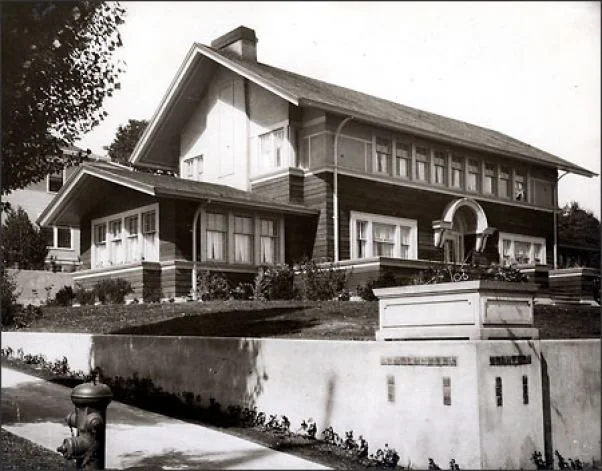J C Black House – 222 West Highland Drive
Built in 1914 on the northeast corner of Highland Drive and 3rd Avenue West, the J. C. Black House was built in a neighborhood of Queen Anne, Arts and Crafts, and Colonial Revival homes. The house’s architect, Andrew Willatsen, practiced in the office of Frank Lloyd Wright before relocating to the Pacific Northwest in 1907. Although Willatsen’s work, the Black House embodied many of the characteristic architectural elements seen in Wright’s Prairie School residences. Located directly across from Kerry Park on the hill's south slope, this home also carried strong influences of the Prairie Style, including the deep, overhanging eaves and the ribbon of windows along the front of the second story.
Historians, preservationists, architects and local citizens loved the house not only for its beauty, but also for its association with Willatsen and Frank Lloyd Wright. For many years, its owner refused efforts to make the house a City of Seattle landmark. Without official Landmark designation, either individually or as part of a district, the house was afforded no protections under Seattle’s preservation ordinance at the time of sale.
The Queen Anne Historical Society did submit a City of Seattle Landmark Nomination for the J.C. Black House in 1979. The owner, Fred Tolan, opposed the nomination. He sent a letter outlining numerous alterations that had been made to the house and site over the years. His letter concluded as follows:
“For the above reasons, it is absurd to characterize our home as of ‘important architectural significance.’ It's nothing like it was in 1914. It has been so totally changed. It is just a good, older home now.“
We do not want a ’landmark’ designation and will resist such a nomination to the limit. We have every intention to keep our home substantially as is as our home for many years in the future. We have kept it up with tender loving care. There is no deferred maintenance. We do not plan to sell the home or change it or demolish it. We do not need or desire ‘economic incentives’ to have us keep the home in top condition. We have always cooperated with the City and we will in the future. We ask you to cooperate with us by dropping this matter.“Please leave things as they are. Our home is not a landmark and we strongly oppose City controls based on factual premises that are unreal."
The estate of Fred Tolan sold the house in 2003 for $2.3 million to Ken Woolcott, a Seattle investor. The description on a building permit submitted on December 29, 2003 states: “Demolish existing single family residence to the foundation & detached accessory structure (garage). Establish use for future construction of a single family residence per plan.“
To the shock of neighbors, the Black House was demolished over the three-day Martin Luther King holiday in January 2004.
After the demolition, Woolcott was quoted in the Seattle PI:
“I did everything legally. Anyone could have bought that house and saved it. Nobody did. It's my dream to live there with a view of Seattle. We're not talking about a commercial space. We're talking about a private home, where I go to bed and get up in the morning. I want to build something that will be an asset to the community and makes sense for the neighborhood.”
The lot remained empty for seven years until the construction of the Kerry Park Court townhouses, consisting of three units starting at $3.2 million each. According to the Wall Street Journal, Mr. Woolcott lives in one of the three townhomes.
For Further Reading
Read more about the architect Willatsen, and another Queen Anne home designed by the firm Willatsen and Byrne at the George Matzen House webpage.
Read papers on the J.C. Black House by University of Washington students (include floor plans):


